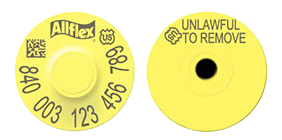
Due to a continued emphasis on livestock traceability within state and federal agencies and the livestock industry, the National Swine Registry (NSR) requires all animals being exhibited at NSR or National Junior Swine Association (NJSA) events be identified with a official, permanently-numbered ear tag. The following information is designed to help answer questions about what is considered a official ear tag and how to obtain these tags.
Example 1: 840 rectangular ear tag without any management number or Premise ID printed on bottom. This is the standard 840 ear tag layout. This would be an acceptable form of ID since each tag still possesses a unique 12 digit number for each animal.

Example 2: 840 ear tag with management number printed on bottom. In this case, the tag purchaser chose to add additional numbers to the blank section of the tag at the bottom for management purposes.

Example 3: 840 ear tag with Premise ID number printed on bottom. Another option is to have your Premise ID printed on the blank section of the tag.

Example 4: 840 round button ear tag

1 Animal Health Protection Act, Section 10408
Example 5: Premise Identification Tags (PIN Tag) are designed for use in breeding swine being shipped to enter harvest channels.

Example 6: Plastic NUES tag from Allflex.

Example 7: Metal NUES tag.
